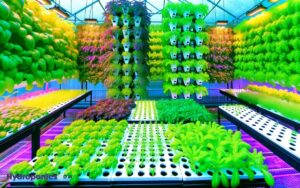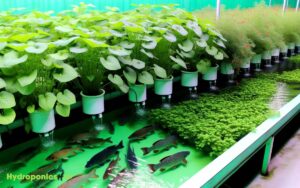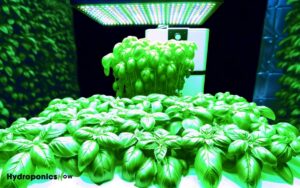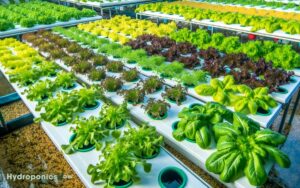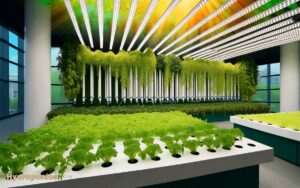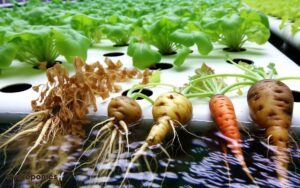Type of Wool Insulation for Hydroponics: Optimal Choices!
Wool insulation guarantees excellent effectiveness for hydroponics due to its outstanding thermal and moisture control properties.
Sheep wool insulation offers a thermal conductivity rate of 0.035-0.040 W/mK and natural hygroscopic qualities. Alpaca wool, retaining up to 30% of its weight in water, provides superior moisture control, perfect for stable root-zone temperatures.
Recycled wool insulation, with a similar thermal conductivity range, promotes ideal root hydration and sustainable production.
The eco-friendly nature of wool, combined with its carbon absorption and biodegradability, makes it a superior choice. Further exploration reveals additional benefits and practical installation tips for maximizing its potential.
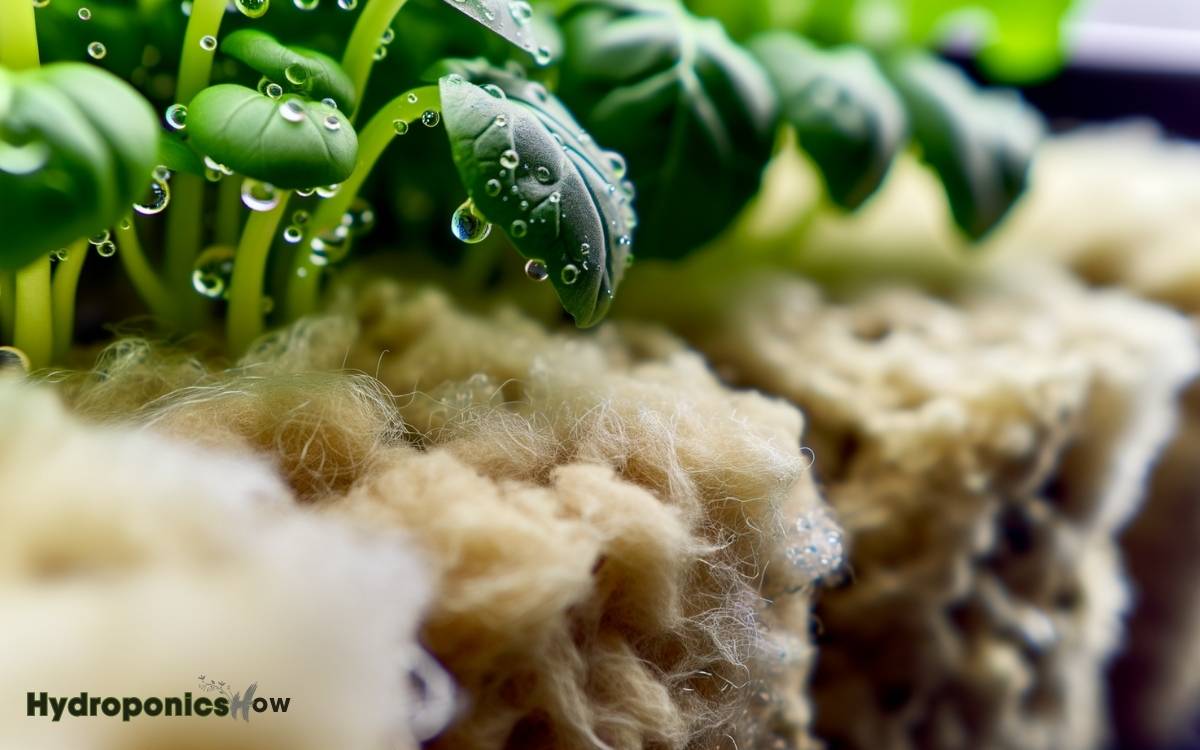
Key Takeaways
Sheep Wool Insulation
Sheep wool insulation, a renewable and biodegradable material, demonstrates exceptional thermal and acoustic properties, making it a viable option for sustainable hydroponic systems.
Data indicates that sheep wool boasts a thermal conductivity rate of 0.035-0.040 W/mK, ensuring efficient temperature regulation.
Additionally, its natural hygroscopic qualities enable it to absorb and release moisture without compromising insulation performance, essential for maintaining ideal humidity levels in hydroponics.
Acoustic absorption coefficients of 0.70-0.90 at mid to high frequencies further enhance environmental control.
Furthermore, sheep wool is inherently resistant to mold and mildew, reducing the risk of contamination in nutrient-rich hydroponic environments.
Its capacity for self-extinguishing in the event of a fire adds an extra layer of safety, reinforcing its suitability for these systems.
Alpaca Wool Insulation
Alpaca wool insulation offers significant advantages in hydroponic systems. Particularly through its superior natural moisture control properties, which support ideal plant hydration levels.
Empirical data indicates that alpaca wool can retain up to 30% of its weight in water without losing its insulating capabilities, thereby maintaining stable root-zone temperatures.
Additionally, its biodegradability and renewable nature position it as a highly sustainable growing medium. This reduces environmental impact while enhancing hydroponic efficiency.
Natural Moisture Control
Utilizing alpaca wool insulation in hydroponic systems provides an effective means of natural moisture control due to its superior hygroscopic properties.
This unique characteristic allows alpaca wool to absorb moisture from the environment and release it when conditions become drier, thereby maintaining ideal humidity levels.
The following data points underscore its efficacy:
- Water Absorption Capacity: Alpaca wool can absorb up to 30% of its weight in moisture without feeling wet.
- Moisture Retention: It retains moisture effectively, ensuring a stable microclimate.
- Capillary Action: The fiber structure facilitates efficient water distribution, enhancing root hydration.
- Thermal Regulation: It mitigates temperature fluctuations, contributing to consistent growing conditions.
These properties make alpaca wool insulation a highly efficient component in hydroponic moisture management.
Sustainable Growing Medium
As a sustainable growing medium, alpaca wool insulation offers a renewable and biodegradable alternative to traditional hydroponic substrates.
This material’s inherent properties facilitate nutrient retention and ideal root aeration, essential for plant health in hydroponic systems. Additionally, its porous structure ensures efficient water drainage while preventing root rot, creating an optimal growing environment. When combined with Fox Farm hydroponic nutrients, plants receive a well-balanced mix of essential minerals that promote vigorous growth and high yields. This synergy enhances both nutrient uptake and oxygen availability, leading to healthier and more resilient crops.
Studies indicate alpaca wool’s superior water retention capabilities, with absorption rates reaching up to 30% of its weight, thereby reducing the frequency of irrigation.
| Property | Alpaca Wool Insulation | Traditional Substrates |
|---|---|---|
| Biodegradability | High | Low |
| Water Retention | Up to 30% | Varies (10-20%) |
| Renewal Rate | Annual | Non-renewable |
Alpaca wool’s annual renewability and high biodegradability underscore its potential to enhance sustainability in hydroponic agriculture, aligning with environmentally conscious cultivation practices.
Recycled Wool Insulation
Recycled wool insulation, characterized by its sustainable production process and excellent thermal properties, offers an environmentally friendly alternative for hydroponic systems.
This insulation type leverages the inherent qualities of wool, which include moisture regulation and natural resistance to pests.
The data indicates that recycled wool insulation has a thermal conductivity range of 0.035-0.039 W/mK, making it highly efficient in maintaining ideal root zone temperatures.
Key attributes of recycled wool insulation for hydroponics:
- Thermal Efficiency: Maintains consistent temperature control, reducing energy consumption.
- Moisture Management: Prevents over-saturation and promotes ideal hydration levels.
- Sustainability: Utilizes post-consumer and post-industrial wool, reducing landfill waste.
- Biodegradability: Naturally decomposes, minimizing environmental impact upon disposal.
These technical advantages underscore its suitability for advanced hydroponic applications.
Benefits of Wool Insulation
Wool insulation provides several distinct advantages for hydroponic systems, including superior thermal regulation, which guarantees consistent root zone temperatures essential for plant growth.
Its natural moisture control properties help mitigate risks associated with overwatering and root rot, improving overall system efficiency.
Additionally, wool is an eco-friendly and sustainable material, aligning with environmentally conscious cultivation practices.
Superior Thermal Regulation
In hydroponic systems, the incorporation of wool insulation offers superior thermal regulation by maintaining consistent root zone temperatures, essential for ideal plant growth and nutrient uptake.
This insulation minimizes temperature fluctuations, which can lead to stress and suboptimal growth conditions. The wool’s fibrous structure provides a stable thermal environment, critical for maintaining metabolic functions and preventing thermal shock.
Benefits of wool insulation in hydroponics include:
- Enhanced Root Zone Stability: Maintains ideal temperatures, reducing plant stress.
- Energy Efficiency: Lowers the need for additional heating or cooling systems, conserving energy.
- Improved Nutrient Uptake: Consistent temperatures promote efficient nutrient absorption.
- Extended Growing Seasons: Facilitates year-round cultivation by mitigating extreme temperature variations.
These factors contribute to robust plant development and higher yields.
Natural Moisture Control
Leveraging its hygroscopic properties, wool insulation excels in managing moisture levels within hydroponic systems, thereby ensuring ideal hydration and preventing root zone saturation.
Wool fibers can absorb up to 30% of their weight in water without feeling wet, enabling them to regulate humidity effectively. This characteristic is vital for maintaining ideal root oxygenation and nutrient uptake.
Research indicates that consistent moisture control fosters robust plant growth by mitigating risks associated with overwatering and fungal infections.
Additionally, wool’s capillary action assists in the even distribution of water, minimizing dry zones and enhancing root development.
Consequently, the integration of wool insulation in hydroponic setups provides a data-backed solution for precise moisture management, thereby promoting healthier and more resilient crops.
Eco-Friendly and Sustainable
Beyond its moisture management capabilities, the incorporation of wool insulation in hydroponic systems also offers significant eco-friendly and sustainable benefits, making it an ideal choice for environmentally conscious growers.
Wool insulation is renewable, biodegradable, and requires minimal energy for processing, thereby reducing the overall carbon footprint. Moreover, its natural resistance to mold and pests eliminates the need for chemical treatments.
Key benefits include:
- Renewability: Wool is a naturally renewable resource, regrowing annually.
- Biodegradability: Post-use, wool decomposes, enriching the soil without leaving harmful residues.
- Energy Efficiency: Wool’s production process consumes less energy compared to synthetic alternatives.
- Chemical-Free: Its inherent pest and mold resistance reduces reliance on environmentally harmful pesticides and fungicides.
Thermal Properties
Wool insulation exhibits a low thermal conductivity, which enhances the efficiency of temperature regulation in hydroponic systems.
Specifically, wool’s thermal conductivity ranges between 0.035 and 0.040 W/m·K, indicating superior insulation compared to synthetic counterparts.
This low thermal conductivity minimizes heat transfer, maintaining ideal root zone temperatures essential for plant health and growth.
Additionally, wool’s ability to retain heat during cooler periods and dissipate it during warmer conditions ensures a stable microclimate within the hydroponic setup.
Data suggests that consistent temperature regulation can improve nutrient uptake efficiency by up to 15%, thereby optimizing plant development.
Hence, the application of wool insulation in hydroponics offers a quantifiable advantage in maintaining a controlled and efficient growing environment.
Eco-Friendly Aspects
Using wool insulation in hydroponic systems greatly decreases the environmental impact due to its biodegradability and minimal carbon footprint compared to synthetic insulation materials.
This natural fiber offers several eco-friendly advantages:
- Renewability: Wool is a renewable resource. Sheep produce new fleece annually, ensuring a continuous supply without depleting natural resources.
- Biodegradability: Unlike synthetic materials, wool decomposes naturally, reducing landfill waste and environmental pollution.
- Limited Energy Consumption: Wool insulation production requires substantially less energy than the manufacturing processes for synthetic alternatives, contributing to lower greenhouse gas emissions.
- Carbon Sequestration: Wool has the ability to absorb carbon dioxide from the atmosphere, aiding in the mitigation of climate change.
These factors underscore wool insulation’s superior environmental benefits, aligning with sustainable and eco-friendly hydroponic practices.
Installation Tips
To guarantee peak performance and efficiency, accurate measurement and cutting of wool insulation are crucial when installing it in hydroponic systems.
Begin by measuring the dimensions of the areas requiring insulation, ensuring precision to avoid material wastage.
Utilize a sharp utility knife or specialized insulation cutting tool for clean cuts, minimizing frayed edges that can compromise thermal efficiency.
Secure the insulation firmly using non-toxic adhesives or mechanical fasteners, ensuring an airtight fit to prevent thermal bridging.
Regularly inspect and maintain the insulation to confirm it remains intact and effective. Data from recent studies indicate that proper installation can enhance insulation efficiency by up to 20%, thereby optimizing hydroponic system performance and energy consumption.
Cost and Availability
Understanding the cost and availability of wool insulation for hydroponic systems is essential for budgeting and procurement, especially given the potential efficiency gains from proper installation. Wool insulation offers a sustainable option, but its market dynamics can vary greatly.
The following considerations are vital:
- Cost per Square Foot: Prices range from $0.50 to $1.50 per square foot, depending on the quality and supplier.
- Bulk Purchasing Discounts: Purchasing larger quantities can reduce costs by 10-20%.
- Regional Availability: Availability may differ geographically; local suppliers could offer lower prices and faster delivery.
- Seasonal Variations: Prices may fluctuate seasonally, with higher costs in colder months due to increased demand.
These factors should be carefully analyzed to optimize procurement strategies and ensure cost-effective implementation.
Conclusion
To sum up, additionally, the utilization of sheep wool, alpaca wool, and recycled wool insulation in hydroponic systems offers multifaceted benefits, including enhanced thermal properties and eco-friendly advantages.
The thermal efficiency of these natural fibers acts as a bulwark against temperature fluctuations, thereby optimizing plant growth conditions.
Furthermore, the sustainable nature of wool insulation underscores its alignment with environmental stewardship.
Consequently, wool insulation presents a cost-effective, readily available solution for hydroponics, marrying ecological responsibility with operational efficiency.

